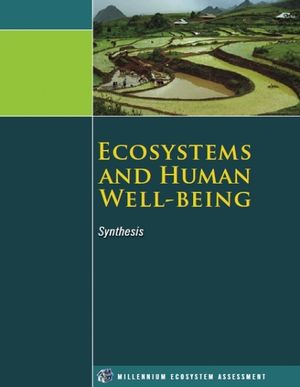Ecosystems and Human Well-being Synthesis: Appendix D. Abbreviations, Acronyms, and Figure Sources
This is part of the Millenium Ecosystem Assessment report Ecosystems and Human Well-Being Synthesis
Contents
Abbreviations and Acronyms
BSE – bovine spongiform encephalopathy
CBD – Convention on Biological Diversity
DALY – disability-adjusted life year
FAO – Food and Agriculture Organization (United Nations)
GDP – gross domestic product
GHS – greenhouse gases
GNI – gross national income
GNP – gross national product
IPCC – [[Panel on Climate Change IUCN – World Conservation Union IVM – integrated vector management MA – Millennium Ecosystem Assessment MEA – multilateral environmental agreement MDG – Millennium Development Goal NGO – nongovernmental organization NPP – net primary productivity NWFP – non-wood forest product OECD – Organisation for Economic Co-operation and Development PA – protected area RBO – river basin organization SARS – severe acute respiratory syndrome SCOPE – Scientific Committee on Problems of the Environment UNCCD – United Nations Convention to Combat Desertification UNEP – United Nations Environment Programme UNFCCC – United Nations Framework Convention on Climate Change WWF – World Wide Fund for Nature
Chemical Symbols, Compounds, Units of Measurement
CH4 – methane CO – carbon monoxide CO2 – carbon dioxide GtC-eq – ton|gigatons of carbon equivalent N – nitrogen N2O – nitrous oxide NOx – nitrogen oxides ppmv – parts per million by volume SO2 – sulfur dioxide teragram – 1012 grams
Figure Sources
Most Figures used in this report were redrawn from Figures included in the technical assessment reports in the chapters referenced in the Figure captions. Preparation of several Figures involved additional information as follows:
Figure 11 (and Figure 3.4)
- The source Figure from CF Box 2.4 was updated to 2003/04 with data from Northern Cod (2J+3KL) Stock Status Update, Fisheries and Oceans Canada, March 2004. </dd>
Figure 14 (and Figure 1.5)
- The source Figure (R9 Fig 9.1) was modified to include the addition of projected human inputs in 2050 based on data included in the original source for R9 Fig 9.1: Galloway, J.P., et al., 2004, Biogeochemistry 70: 153–226. </dd>
Figure 1.6
- The source Figure (R9 Fig 9.2) was modified to include two additional deposition maps for 1860 and 2050 that had been included in the original source for R9 Fig 9.2: Galloway, J.P., et al., 2004, Biogeochemistry 70: 153–226. </dd>
Figure 1.7
- This Figure was developed from two Figures included in articles cited in C11.3.1: Ruiz et al., 2000, Annual Review of Ecology and Systematics 31: 481-531 (Fig 1c); Ribera Siguan 2003, in G.M. Ruiz and J.T. Carlton eds., Invasive Species: Vectors and Management Strategies, Island Press, Washington D.C. (Fig 8.5). </dd>
Figures B and C in Box 3.1 - Linkages between Ecosystem Services and Human Well-being
- The source Figures (C7 Fig 7.13 and 7.14) are based on World Health Organization and United Nations Children’s Fund, 2000: Global Water Supply and Sanitation Assessment 2000 Report, World Health Organization, Geneva, updated for 2002 using the WHO online database. </dd>
Figure 3.1
- This Figure was developed from the database cited in C5.2.6 using World Bank figures for “adjusted net savings” for 2001, downloaded from lnweb18.worldbank.org/ ESSD/envext.nsf/44ByDocName/Green AccountingAdjustedNetSavings on January 25, 2005.</dd>
Figure 3.6
- The source Figure (S7 Fig 7.3) is based on Figure 3-9 in Panel for Climate Change, 2000: Special Report on Emissions Scenarios, Cambridge University Press, Cambridge, U.K. </dd>
Figures 4.1 and 4.2
- The source Figures (S7 Figs 7.6a and 7.6b) are based on data downloaded from the online World Bank database and reported in World Bank, 2004: World Development Report 2004: Making Services Work for Poor People, World Bank, Washington D.C. </dd>
Figure 8.1
- The source Figure (C5 Box 5.2) is redrawn from Figure 7 in World Bank, 2004: State and Trends of the Carbon Market - 2004. World Bank, Washington D.C.</dd>
Terms of Use
The copyright for material on this page is the property of the World Resources Institute. Click here for the Terms of Use (Ecosystems and Human Well-being Synthesis: Appendix D. Abbreviations, Acronyms, and Figure Sources)].
Disclaimer: This chapter is taken wholly from, or contains information that was originally written for the Millennium Ecosystem Assessment as published by the World Resources Institute. The content has not been modified by the Encyclopedia of Earth.
|
|
